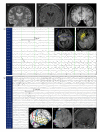Temporal lobe epilepsy surgery failures: a review
- PMID: 22934162
- PMCID: PMC3420575
- DOI: 10.1155/2012/201651
Temporal lobe epilepsy surgery failures: a review
Abstract
Patients with temporal lobe epilepsy (TLE) are refractory to antiepileptic drugs in about 30% of cases. Surgical treatment has been shown to be beneficial for the selected patients but fails to provide a seizure-free outcome in 20-30% of TLE patients. Several reasons have been identified to explain these surgical failures. This paper will address the five most common causes of TLE surgery failure (a) insufficient resection of epileptogenic mesial temporal structures, (b) relapse on the contralateral mesial temporal lobe, (c) lateral temporal neocortical epilepsy, (d) coexistence of mesial temporal sclerosis and a neocortical lesion (dual pathology); and (e) extratemporal lobe epilepsy mimicking TLE or temporal plus epilepsy. Persistence of epileptogenic mesial structures in the posterior temporal region and failure to distinguish mesial and lateral temporal epilepsy are possible causes of seizure persistence after TLE surgery. In cases of dual pathology, failure to identify a subtle mesial temporal sclerosis or regions of cortical microdysgenesis is a likely explanation for some surgical failures. Extratemporal epilepsy syndromes masquerading as or coexistent with TLE result in incomplete resection of the epileptogenic zone and seizure relapse after surgery. In particular, the insula may be an important cause of surgical failure in patients with TLE.
Figures


References
-
- Sander JW, Hart YM, Johnson AL, Shorvon SD. National general practice study of epilepsy: newly diagnosed epileptic seizures in a general population. The Lancet. 1990;336(8726):1267–1271. - PubMed
-
- Kwan P, Brodie MJ. Early identification of refractory epilepsy. The New England Journal of Medicine. 2000;342(5):314–319. - PubMed
-
- Wiebe S, Blume WT, Girvin JP, Eliasziw M. A randomized, controlled trial of surgery for temporal-lobe epilepsy. The New England Journal of Medicine. 2001;345(5):311–318. - PubMed
-
- McIntosh AM, Kalnins RM, Mitchell LA, Fabinyi GCA, Briellmann RS, Berkovic SF. Temporal lobectomy: long-term seizure outcome, late recurrence and risks for seizure recurrence. Brain. 2004;127(9):2018–2030. - PubMed
-
- Jeha LE, Najm IM, Bingaman WE, et al. Predictors of outcome after temporal lobectomy for the treatment of intractable epilepsy. Neurology. 2006;66(12):1938–1940. - PubMed
LinkOut - more resources
Full Text Sources

